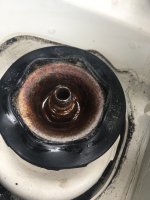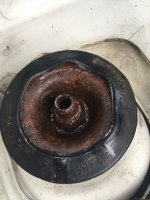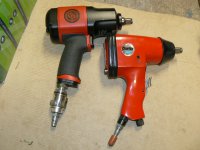What is your air gun? Here are the two I own:
View attachment 211698
The bottom one is a "reasonably priced" Clarke gun from Machine Mart. It works well enough on most wheel bolts etc but won't look at anything reasonably tight. The top one is a considerably more expensive Chicago Pneumatic which is all together a different beast - I've nick named it "The Hooligan" and it hasn't failed to shift anything I've tried it on yet - Hub nuts, Crank Pulley bolts, etc.
You may notice the Clarke gun (which I've owned for much longer than the CP) is fitted, in this picture, with a typical PCL connector and I ran it on a 1/4" bore hose. When I got the CP, only a few years ago, it came without a connector at all and, as I'd just bought my new compressor at that time, which was fitted with the larger bore "Euro" type connectors I invested in some larger bore hose (3/8") and some Euro connectors which I fitted to the CP and retrofitted to the Clarke gun. This lets it get considerably more air and has improved it's performance significantly but it still can't hold a candle to the CP. You may see the CP has an automatic oiler too? I have found over the years that tools fitted with these last much longer and the Clarke now has one too. If you don't fit one you must give it a squirt of oil down the connector before use each time. However using an oiler and PROPER AIRINE OIL has a hidden advantage. Airline oil helps counter the corrosive effects of moisture in the air supply and reduces internal rusting of the gun - or so it says on the stuff i bought.
I thought that, having bought the CP I would probably "retire" the Clarke but actually the two complement each other very well. The CP tackles all the stuff I know is going to be really tight but there's always the risk it'll just shear off smaller fittings so for these I use the Clarke so, far from going into retiral, the Clarke probably see more use than the CP.
So, I suppose what I'm saying is that air guns from the more budget orientated end of the market like my Clarke are, in my experience, rather limited in what you can expect of them and I'm not surprised to hear that, if yours is one of these, it wasn't up to tackling that strut nut.
So glad to hear you've got the job done though and that labour charge sounds very reasonable to me. Thanks also for keeping us up to speed with how things worked and that the car feels good.
How long might a shocker last? That's a "how long is a piece of string" type question. Probably the most common failure on shocks is that the fluid seal fails and they start to leak- immediate MOT failure of course. They can also wear internally so that the resistance becomes greatly reduced and the wheel can then bounce up and down uncontrolled, which can give the car some very strange and dangerous handling characteristics. (you can get some idea on this if you "bounce" each corner of the car up and down, by pushing on the wing (mind you don't dent it) I find I like to work it up to a good bounce by pressing down two or three times and then pushing down strongly on the last Bounce then standing back and observing. The car shouldn't really "bounce" at all. If it does that shocker is weak and needs changed. If you are in doubt about whether you are seeing "bounce" try comparing it with bouncing one of the other corners of the car. It's rare for all shockers to wear out at the same time. Rubber bushes top and bottom are common also, especially on the type where the spring is integral with the shocker and takes the car's weight, unlike ours where the road spring is separate. Then, less commonly, you can get a bent damper rod, serious corrosion (both of the barrel or mounting lugs), damaged or missing shroud (which protects the damper rod) - Can't thing what else! Predicting how long it might take for any of this to happen depends very much on what the damper is subjected to. When I worked in that wee country garage I've seen farmers vehicles which needed shocks done so often they should have taken shares in the companies making them! In more usual everyday use the sort of thing which is going to really kill them is going over speed bumps too fast. If you go fast enough to cause a significant compression of the shocker on every bump
 View attachment 1
View attachment 1 View attachment 1
View attachment 1



